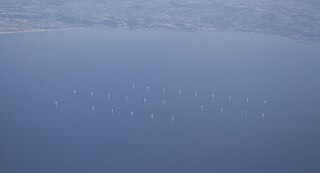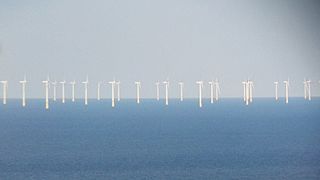
The United Kingdom is the best location for wind power in Europe and one of the best in the world. The combination of long coastline, shallow water and strong winds make offshore wind unusually effective.

Greater Gabbard is a 504 MW wind farm, built on sandbanks 23 kilometres (14 mi) off the coast of Suffolk in England at a cost of £1.5 billion. It was completed on 7 September 2012 with all of the Siemens SWT3.6–107 turbines connected. Developed as a joint venture between Airtricity and Fluor, it is now jointly owned by SSE Renewables and Innogy.

Wind power became a significant energy source within South Australia over the first two decades of the 21st century. In 2015, there was an installed capacity of 1,475 MW, which accounted for 34% of electricity production in the state. This accounted for 35% of Australia's installed wind power capacity. In 2021, there was an installed capacity of 2052.95 MW, which accounted for 42.1% of the electricity production in the state in 2020.
Atlantic Array was a proposed offshore wind farm in the Bristol Channel, off the coast of North Devon and South Wales, United Kingdom. It was a development by RWE Npower Renewables. With a planned 1.2 gigawatt capacity, it would have been one of the world's largest offshore wind farms. The project was cancelled in November 2013.

North Hoyle Offshore Wind Farm is Wales' first offshore wind farm, and the UK's first major offshore renewable power project. Situated in Liverpool Bay, it commenced operation in 2003.

Rhyl Flats Offshore Wind Farm is a 25 turbine wind farm approximately 8 km north east of Llandudno in North Wales. It is Wales' second offshore wind farm and the third offshore wind farm to be built within Liverpool Bay. It has a maximum rated output of 90 MW.

Gwynt y Môr is a 576-megawatt (MW) offshore wind farm located off the coast of north Wales and is the fifth largest operating offshore windfarm in the world. The farm has 160 wind turbines of 150 metres (490 ft) tip height above mean sea level.

The Kentish Flats Offshore Wind Farm is a wind farm located off the coast of Kent, England on a large, flat and shallow plateau just outside the main Thames shipping lanes. The wind farm is operated by Vattenfall.
Triton Knoll Wind Farm is an 857 MW round 2 offshore wind farm 33 kilometres (21 mi) off the coast of Lincolnshire, in the North Sea, England.
Dudgeon Offshore Wind Farm is an offshore wind farm 32 km north of Cromer off the coast of Norfolk, in the North Sea, England. It is owned by Dudgeon Offshore Wind Limited (DOW), a subsidiary of Equinor, Masdar and Statkraft. The site is a relatively flat area of seabed between the Cromer Knoll and Inner Cromer Knoll sandbanks and is one of the furthest offshore sites around the UK.

Rampion is an offshore wind farm developed by E.ON, now operated by RWE, off the Sussex coast in the UK. The wind farm has a capacity of 400 MW. The wind farm was commissioned in April 2018 and was the first offshore wind farm for the whole south coast of England.
Viking Wind Farm is a large on-shore wind farm under construction in the Shetland Islands which is being developed by Viking Energy, a partnership between Shetland Islands Council and SSE plc. When complete, it will have a generation capacity of 443 MW.
Navitus Bay Wind Park was a proposed 970 MW Round 3 offshore wind farm, to be situated off the English coast approximately 10 km south of Dorset and the Isle of Wight. The wind farm was refused planning permission in September 2015.
Stockyard Hill Wind Farm is a wind farm project in Victoria (Australia). In October 2022 the project completed its hold point tests, and was approved by the Australian Energy Market Operator and Network Services Provider to generate up to its maximum capacity of 511MW into the National Electricity Market.
Dogger Bank Wind Farm is a group of offshore wind farms under construction 130 to 200 kilometres off the east coast of Yorkshire, England in the North Sea. It is considered to be the world's largest offshore windfarm. It was developed by the Forewind consortium, with three phases envisioned - first phase, second phase and third phase. In 2015, the third phase was abandoned, while the first and second phases were granted consent. It was initially expected that the Dogger Bank development will consist of four offshore wind farms, each with a capacity of up to 1.2 GW, creating a combined capacity of 4.8 GW. As of 2023, a total of 277 turbines are expected to be built and produce a capacity of 3.6 GW, enough to power 6 million homes.

The East Anglia Array is a proposed series of offshore wind farms located around 30 miles off the east coast of East Anglia, in the North Sea, England. It has begun with the currently operational East Anglia ONE, that has been developed in partnership by ScottishPower Renewables and Vattenfall. Up to six individual projects could be set up in the area with a maximum capacity of up to 7.2 GW. The first project, East Anglia ONE at 714 MW, received planning consent in June 2014 and contracts in April 2016. Offshore construction began in 2018 and the project was commissioned in July 2020. It is expected to cost £2.5 billion.

In 2019, Wales generated 27% of its electricity consumption as renewable electricity, an increase from 19% in 2014. The Welsh Government set a target of 70% by 2030. In 2019, Wales was a net exporter of electricity. It produced 27.9 TWh of electricity while only consuming 14.7 TWh. The natural resource base for renewable energy is high by European standards, with the core sources being wind, wave, and tidal. Wales has a long history of renewable energy: in the 1880s, the first house in Wales with electric lighting powered from its own hydro-electric power station was in Plas Tan y Bwlch, Gwynedd. In 1963, the Ffestiniog Power Station was constructed, providing a large scale generation of hydroelectricity, and in November 1973, the Centre for Alternative Technology was opened in Machynlleth.










